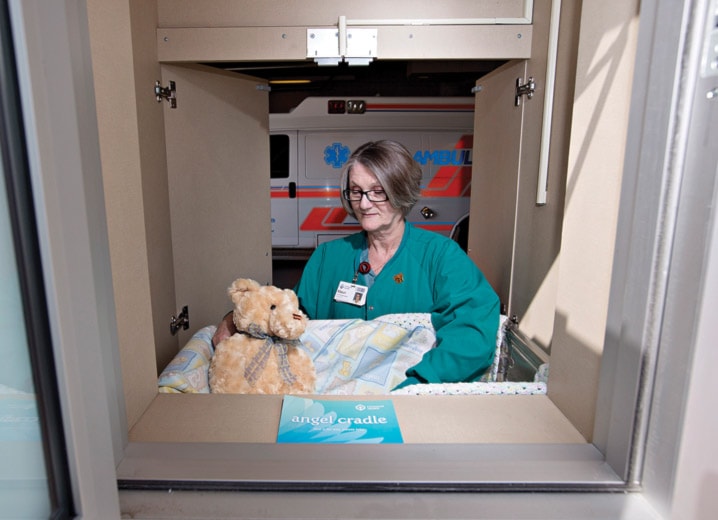EDMONTON — A door in the wall opens to a cupboard-like space, just big enough for a tiny baby.
Inside there’s a plastic bassinet containing a hand-knit blanket, a brown teddy bear and an information card.
“Your baby will be safe and you will be safe,” it reads.
The site is one of two that opened Monday at hospitals in Edmonton where overwhelmed parents can abandon their newborn babies — no questions asked.
Health officials believe the only other program of its kind in Canada is at St. Paul’s Hospital in Vancouver. That site has received one child since it opened three years ago.
Family doctor Irene Colliton helped open one of the Angel Cradles at the Grey Nuns Community Hospital in southeast Edmonton. The other is on the west side of the city at the Misericordia hospital.
Colliton often delivers babies and understands what a tumultuous and sometimes catastrophic event it can be for new parents. And although there are social agencies that offer help, Colliton said safe haven drop-off sites should be available as a last resort.
“This is a safety net,” she said. “If it’s only used once — or it’s used never — then we will have done a good thing.”
Gordon Self, a vice-president with Covenant Health, the Catholic health-care group that operates the two Edmonton hospitals, said the Angel Cradles project began a few years ago.
He wasn’t sure there was a need for the sites, but then learned from hospital staff that they had admitted female patients who had obviously gone through childbirth but had no babies with them.
There have also been criminal cases across the country involving young moms who hide their pregnancies or are surprised by childbirth, then discard their newborns.
Self recalled the story of a young woman who admitted last week in Saskatoon court to giving birth at home when she was 17. Her baby girl died sometime after the delivery and she put the body in the garbage.
Self said a person who leaves a newborn at the hospital site can remain anonymous. There is no surveillance camera. And although an alarm is triggered once the drop-off door is opened, it’s delayed by 45 seconds, giving the adult enough time to walk away.
He added that government social workers are obligated to try to determine the identities of the baby’s parents.
But medical staff won’t be involved.
“As long as the newborn is left safely with no evidence of being harmed, we’re not obligated to report or connect the baby with the mother — even if the mother presents minutes or hours later in our emergency department.”
The United Nations Committee on the Rights of the Child has expressed concern over the boxes, arguing there’s no evidence they save lives. The group said it’s a priority that children be able to identify their parents.
Information cards inside the sites contain crisis phone numbers and remind parents that they’re allowed to change their minds. Self said parents can be reunited with their children.
Child abandonment is illegal in Canada, but police have advertised in the past that they won’t charge mothers who leave their babies in safe places. “Baby Moses” laws in the United States allow people to avoid prosecution if they leave children at hospitals, police stations or fire halls.
The concept dates back to the 12th century, when the Catholic church put foundling wheels in its churches and orphanages. The wheels were attached to walls and rotated in and out of the buildings.
So-called “baby boxes” have spread through Europe and Asia over the past few decades.
